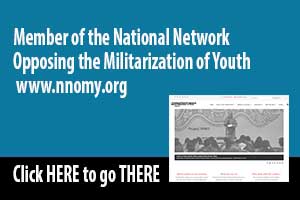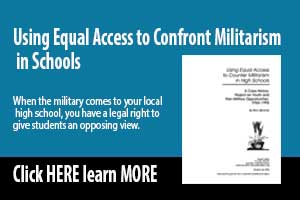From Draft NOtices, January-March 2019
— Marshall Blesofsky  On February 14, 2018, the unthinkable but all-too-common happened. A mass shooting occurred at the Marjory Stoneman Douglas High School in Parkland, Florida. Rumors about the identity of the shooter were that he was a former student who had been in JROTC. One week later, on Democracy Now, Amy Goodman's guest was Pat Elder, the director of the National Coalition to Protect Student Privacy. This organization works to counter the access that the military has to students in high schools. Mr. Elder went on to state that the shooter was trained in the marksmanship program at the same high school. On the day of the murders, the shooter wore his JROTC shirt. Also, among the killed were three JROTC students.
On February 14, 2018, the unthinkable but all-too-common happened. A mass shooting occurred at the Marjory Stoneman Douglas High School in Parkland, Florida. Rumors about the identity of the shooter were that he was a former student who had been in JROTC. One week later, on Democracy Now, Amy Goodman's guest was Pat Elder, the director of the National Coalition to Protect Student Privacy. This organization works to counter the access that the military has to students in high schools. Mr. Elder went on to state that the shooter was trained in the marksmanship program at the same high school. On the day of the murders, the shooter wore his JROTC shirt. Also, among the killed were three JROTC students.
Long Beach Recruitment Awareness Project (LB RAP) is an organization that has been working to safeguard the privacy of students through what we call truth-in-recruitment. Military recruiters in our school district can visit the schools almost any time they wish. They collect student contact information and use it to pursue them. We have documented cases of students who have been hounded by recruiters without their parents' consent and lured by false promises to join the military.
Our organization was aware that there were two JROTC shooting ranges in Long Beach Unified School District (LBUSD) -- one at Long Beach Polytechnical High School and one at Lakewood High School. I personally had knowledge of the rifle range at Poly High School because both of my children graduated from that school. LB RAP decided to put together a flyer and a petition and begin a campaign to rid the school district of these shooting ranges. On March 24, Long Beach had their own March for Our Lives rally that was organized by high school students in the area. Long Beach Area Peace Network and LB RAP collected signatures and distributed our petition. Many people were shocked to learn that Long Beach Unified School District had these shooting ranges.
We also made this a political issue in the upcoming school board election. We went to candidates’ forums and got the candidates to speak about the issue. Both of the individuals running for the board of education were very supportive. One of them stated that closing these shooting ranges was a no-brainer. After conferring with Pat Elder and Rick Jahnkow of the Project of Youth and Non-Military Opportunities (YANO), we learned that many of these programs were supported by the National Rifle Association (NRA). A local community leader who is not a member of the peace movement sent a Public Records Act request to the district in an effort to learn whether the NRA had ever donated money or in-kind donations to the JROTC programs at the schools. Although it turns out the NRA made no such donations, we speculate that this inquiry made the school district wary of scrutiny around the issue of shooting ranges.
Over the course of about four months, we gathered approximately 400 petition signatures and prepared for a meeting with the school board and the superintendent. Our request on our flyers was that signers should call their school board member and the superintendent’s office. We know that a few calls were made.
Before going to the school board, we always meet with the superintendent. This is because a community group that studies the political power structure determined that the Long Beach Board of Education almost always conforms to the wishes of the superintendent. Over the last few years, LB RAP has met periodically with the superintendent. Long Beach is one of the few large districts in California that does not have a policy concerning military recruiting in the schools. While the meetings have been cordial, they have never been very fruitful. The superintendent did say that ours was the only group that he had heard from on this issue.
Prior to meeting with the school board about the shooting ranges, we met with the superintendent in late September. Unlike previous meetings where we felt that the superintendent was somewhat unimpressed by our presentation, this time he was very engaged. When we asked about the status of the shooting ranges, he explained that over the summer, because of construction and renovations, the active shooting ranges at Poly High School and Lakewood High School had been closed permanently! There was another shooting range at Jordan High School that is unused because the JROTC program ended at that school. Jordan High School is also presently being replaced by a new facility.
There are some lessons to note from this campaign:
- It was important for LB RAP to be persistent in its efforts to effect change.
- Because of the mass shooting in Florida, we were able to find a weak spot in the military presence in the LBUSD school system.
- We chose a campaign that had specific, achievable goals.
- It helped that the campaign made shooting ranges a political issue in the race for school board.
- Our petition served as a public education campaign which enlightened hundreds of people.
There is still an awful lot we need to do to educate the students and their parents about issues of privacy and the military's presence in schools. Also, while there are peace clubs at some campuses, we could use more at selected schools in Long Beach.I want to thank all the people that have been involved in Long Beach RAP and the Long Beach Area Peace Network for being so supportive.
Marshall Blesofsky is a long time peace activist who worked with the Boston Draft Resistance Group in the 1960s. He is a founder and chair of the Long Beach Recruitment Awareness Project in California, which organized to remove all JROTC shooting ranges from the Long Beach Unified School District.
This article is from Draft NOtices, the newsletter of the Committee Opposed to Militarism and the Draft (http://www.comdsd.org/).





